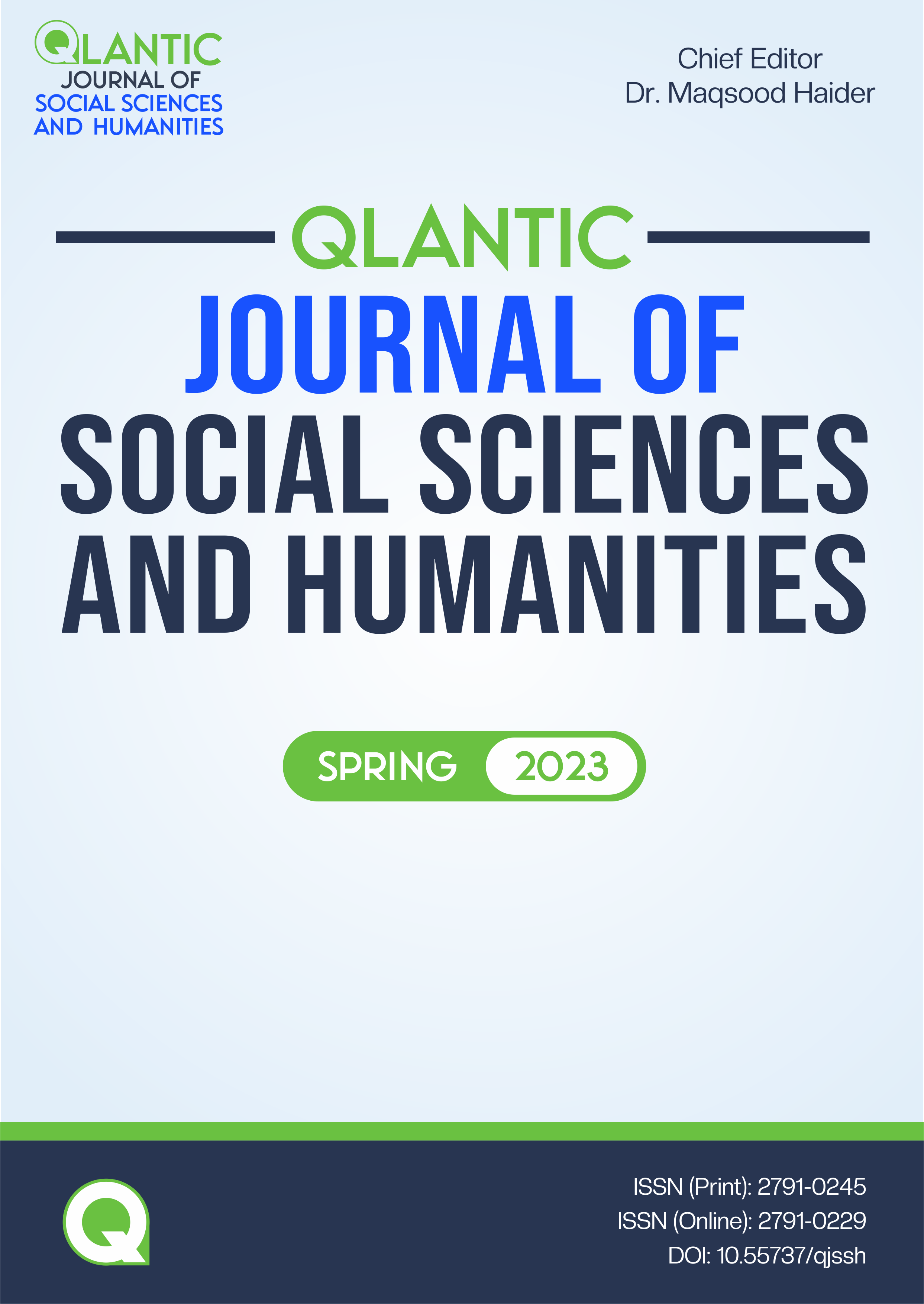Analyzing the Current State of Coal Consumption and Combustion in Pakistan, including Trends, Patterns, and Major Sources of Coal Emissions
DOI:
https://doi.org/10.55737/qjssh.163997506Keywords:
Coal, Climate Change, CO2, GHG, SO2Abstract
Coal consumption, a major contributor to greenhouse gas emissions, is closely linked to the effects of climate change in Pakistan. This paper investigates the complicated relationship between coal consumption and the effects on the country's climate. As Pakistan seeks to meet its energy needs while also supporting economic growth, the environmental consequences of coal use must be carefully examined. This study assesses the extent of coal-related emissions, their influence on local and global climate patterns, and the subsequent environmental and socioeconomic implications using a comprehensive review of literature, data analysis, and climate modelling. The article examines Pakistan's coal usage, including home heating, industrial operations, and electricity generation, highlighting the need for greener energy sources and strategies to reduce coal reliance and promote sustainable growth.. Furthermore, the study looks into the short-term and long-term climate effects of coal consumption in Pakistan. It investigates temperature changes, precipitation patterns, glacial melting, sea-level rise, and extreme weather events, as well as the consequences for agriculture, water resources, and vulnerable communities. The paper also examines the country's vulnerability to climate change and the need for adaptation measures to effectively address its effects.
References
Ahmadani, A. (2017, April 17). Profit explains: Why is Pakistan moving towards coal as its main energy source while the rest of the world moves away? Profit by Pakistan Today. https://profit.pakistantoday.com.pk/2017/04/17/mining-our-way-to-zero-loadshedding/
Ahmed, M., Zafar, S., & Altaf, M. (2021). Socio-Economic and Environmental Impact of Coal Mining Industry in Thar Block II. Pakistan Journal of Science, 73(1), 1-11.
Ahsan, N., Farooqi, S. S., & Pervaiz, K. (2020). Techno-Economic and Environmental Analysis of Thar Coal Project in Pakistan. Renewable and Sustainable Energy Reviews, 120, 109646.
Ali, Q. ul A., Khayyam, U., & Nazar, U. (2020). Energy Production and CO2 Emissions: The Case of Coal Fired Power Plants under China Pakistan Economic Corridor. Journal of Cleaner Production, 124974. https://doi.org/10.1016/j.jclepro.2020.124974
Amjed, N., Iqbal, M., Ijaz Ahmad Bhatti, & Nazir, A. (2017). Coal desulphurization and conditions optimization through response surface methodology, Khushab mines, Pakistan. Energy Sources Part a Recovery Utilization and Environmental Effects, 39(12), 1235–1241. https://doi.org/10.1080/15567036.2017.1319439
Ayaz, M., Jehan, N., Nakonieczny, J., Mentel, U., & uz zaman, Q. (2022). Health costs of environmental pollution faced by underground coal miners: Evidence from Balochistan, Pakistan. Resources Policy, 76, 102536. https://doi.org/10.1016/j.resourpol.2021.102536
Bari, A. Mirani N. & Bilal, M. (2019). Coal Energy Potential in Pakistan: An Overview. International Journal of Energy and Environmental Engineering, 10(2), 203-214.
Burke, A., & Fishel, S. (2020). A coal elimination treaty 2030: Fast tracking climate change mitigation, global health and security. Earth System Governance, 3, 100046. https://doi.org/10.1016/j.esg.2020.100046
Falak, F., Ayub, F., Zahid, Z., Sarfraz, Z., Sarfraz, A., Robles-Velasco, K., & Cherrez-Ojeda, I. (2022). Indicators of Climate Change, Geospatial and Analytical Mapping of Trends in India, Pakistan and Bangladesh: An Observational Study. International Journal of Environmental Research and Public Health, 19(24), 17039. https://doi.org/10.3390/ijerph192417039
Jabbar Khan, A., Akhter, G., Gabriel, H. F., & Shahid, M. (2020). Anthropogenic Effects of Coal Mining on Ecological Resources of the Central Indus Basin, Pakistan. International Journal of Environmental Research and Public Health, 17(4), 1255. https://doi.org/10.3390/ijerph17041255
Mirza, M. Q. (2020). Climatic Change and Pakistan. In Springer Climate (pp. 61-78). Springer, Cham.
Nasir, S., Khan, M. H., Khan, M. N., & Shahbaz, B. (2016). Impact of SO2 and NOx on Rainwater Chemistry at Rawalakot, Azad Jammu and Kashmir (Pakistan). Air Quality, Atmosphere & Health, 9(5), 551-560.
Rauf, A., Ahmad, S., & Ali, S. (2020). Climate Change Mitigation Strategies for Pakistan: The Role of Renewable Energy Resources. Journal of Renewable and Sustainable Energy Reviews, 117, 109487.
Raza, M. A., Khatri, K. L., Memon, M. A., Rafique, K., Haque, M. I. U., & Mirjat, N. H. (2022). Exploitation of Thar coal field for power generation in Pakistan: A way forward to sustainable energy future. Energy Exploration & Exploitation, 014459872210821. https://doi.org/10.1177/01445987221082190
Sáez-Martínez, F. J., Lefebvre, G., Hernández, J. J., & Clark, J. H. (2016). Drivers of sustainable cleaner production and sustainable energy options. Journal of Cleaner Production, 138, 1–7. https://doi.org/10.1016/j.jclepro.2016.08.094
Satti, S. L., Hassan, M. S., Mahmood, H., & Shahbaz, M. (2014). Coal consumption: An alternate energy resource to fuel economic growth in Pakistan. Economic Modelling, 36, 282–287. https://doi.org/10.1016/j.econmod.2013.09.046
Shahani, N. M., Sajid, M. J., Zheng, X., Brohi, M. A., Jiskani, I. M., Ul Hassan, F., & Qureshi, A. R. (2020). Statistical analysis of fatalities in underground coal mines in Pakistan. Energy Sources, Part A: Recovery, Utilization, and Environmental Effects, 1–16. https://doi.org/10.1080/15567036.2020.1841340
Wilberforce, T., Olabi, A. G., Sayed, E. T., Elsaid, K., & Abdelkareem, M. A. (2020). Progress in carbon capture technologies. Science of the Total Environment, 761(143203), 143203. https://doi.org/10.1016/j.scitotenv.2020.143203
Published
Issue
Section
License

This work is licensed under a Creative Commons Attribution-NonCommercial 4.0 International License.





